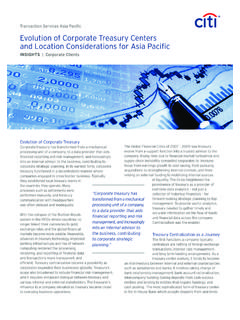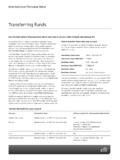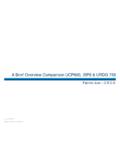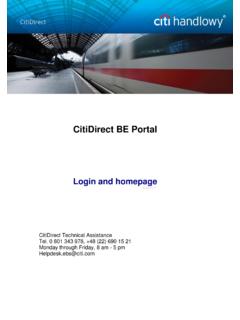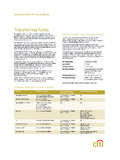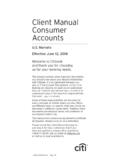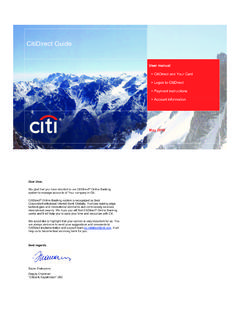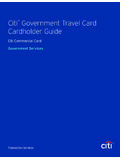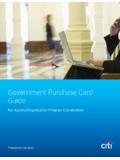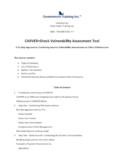Transcription of RATING METHODOLOGY Moody’s Revised Money ... - Citi.com
1 RATING METHODOLOGY GLOBAL MANAGED INVESTMENTS MARCH 10, 2011 Table of Contents: REASONS FOR INTRODUCING Revised Money MARKET FUND METHODOLOGY 1 NEW RATING SYMBOLS AND DEFINITIONS 2 OVERVIEW OF moody S Revised Money MARKET FUND METHODOLOGY 3 APPENDIX I 10 moody S RELATED RESEARCH 11 Analyst Contacts: PARIS Yaron Ernst Managing Director LONDON Mike Eberhardt Vice President Senior Analyst NEW YORK Daniel Serrao Senior Vice President Henry Shilling Senior Vice President Ted Collins Managing Director Credit Policy Contact: NEW YORK Barbara Havlicek Senior Vice President moody s Revised Money Market Fund RATING METHODOLOGY and Symbols In this report, we present our Revised RATING METHODOLOGY for RATING Money market funds. The analytical framework uses a set of objective measures to assess portfolio credit quality as well as market and liquidity risks in stress scenarios in order to differentiate among funds.
2 In addition, we are introducing a new set of RATING symbols and definitions that better address the unique risks of Money market funds and distinguish our Money market fund ratings from our credit ratings . This new RATING METHODOLOGY is scheduled to become effective on 20 May 2011, and all existing Money market ratings will be migrated then to the new RATING symbols based on the new METHODOLOGY . Our Revised Money market fund RATING METHODOLOGY incorporates market feedback that we received after publishing our Request for Comment on the same subject in September 2010. Once effective, the new METHODOLOGY will supersede the following principal methodologies as they apply to Money market funds: moody s Managed Funds Credit Quality ratings METHODOLOGY and moody s Money Market and Bond Fund Market Risk ratings , both published in 2004.
3 Reasons for Introducing Revised Money Market Fund METHODOLOGY The introduction of moody s Revised Money market fund METHODOLOGY reflects experience gained from the tumultuous period in late 2008 when disruptions in short-term funding markets caused market value declines and record outflows from prime Money market funds. During this period, a large Money market fund The Reserve Primary Fund broke the buck and suspended redemptions together with funds managed by the same fund family. Many other funds experienced stress within their portfolios and elevated redemptions at the same time, heightening systemic risk. Ultimately, support from the US Treasury, via the introduction of a guaranty fund for Money market fund investors, served to stem investor outflows and prevent a disorderly unwind of Money market funds.
4 The financial crisis had a significant impact on investors in Money market funds. Some, particularly those invested in Reserve Management Funds, suffered payment delays and principal losses. As a result, investors have become more sensitive to the differences among Money market funds and increasingly focused on the wide range of Money market fund risks including: 1) vulnerability to market and liquidity risks despite portfolios consisting of highly-rated assets in addition to credit risk; 2) susceptibility to redemption risk, particularly if there is a concentrated investor base; 3) the quality and stability of the fund sponsor, whose support was generally forthcoming in the crisis, but not certain. GLOBAL MANAGED INVESTMENTS 2 MARCH 10, 2011 RATING METHODOLOGY : moody S Revised Money MARKET FUND RATING METHODOLOGY AND SYMBOLS moody s Revised Money market fund RATING METHODOLOGY better captures these risks by introducing an analytic assessment of two distinct fund factors: Portfolio Credit Profile (the quality of the assets in the portfolio) and Portfolio Stability Profile (including market and liquidity risks in stress scenarios).
5 A set of standardized objective measures will be used in a composite evaluation of these two key factors. By extending our analysis of Money market funds in areas that are increasingly important to investors, there will be greater differentiation and transparency than under our existing METHODOLOGY . New RATING Symbols and Definitions We have historically used a slightly modified version of our traditional long-term obligation credit RATING scale (Aaa to C) in RATING Money market funds1 Given the unique nature of Money market funds that is, investors own shares in the fund yet expect to be able to withdraw their funds on demand we will rate Money market funds based on our opinion of their ability to meet the dual objectives of preserving principal and providing liquidity to holders.
6 A Money market fund s risk will be expressed through RATING symbols similar to our current RATING symbols and market convention, but will append a Money market fund or mf modifier to highlight the distinct meaning of our Money market fund ratings as noted in Figure 1.. However, Money market funds are distinct from long-term fixed income instruments in that while they are generally undated, they are typically viewed as short-term investments and investors expect to be able to withdraw their funds on demand. From a strictly legal perspective, Money market fund investors own shares that represent an interest in a portfolio of securities. FIGURE 1 Money Market Fund (mf) RATING Definitions RATING Definition Aaa-mf Money market funds rated Aaa-mf have very strong ability to meet the dual objectives of providing liquidity and preserving capital.
7 Aa-mf Money market funds rated Aa-mf have strong ability to meet the dual objectives of providing liquidity and preserving capital. A-mf Money market funds rated A-mf have moderate ability to meet the dual objectives of providing liquidity and preserving capital. Baa-mf Money market funds rated Baa-mf have marginal ability to meet the dual objectives of providing liquidity and preserving capital. B-mf Money market funds rated B-mf are unable to meet the objective of providing liquidity and have marginal ability to meet the objective of preserving capital. C-mf Money market funds rated C-mf are unable to meet either objective of providing liquidity or preserving capital. In addition to differentiating Money market fund ratings from our long-term obligation credit ratings , our new symbol set addresses a requirement under Section 938 of the Dodd-Frank Wall Street and Consumer Protection Act for RATING agencies to use distinct symbols for ratings with distinct meanings.
8 1 Previously, moody s Money Market Fund ratings were expressed by using symbols at the broad RATING category level without the use of modifiers ( , -1, -2, -3). European Constant Net Asset Value (CNAV) funds were rated on the same scale and also assigned an MR1+ symbol to denote their CNAV status. GLOBAL MANAGED INVESTMENTS 3 MARCH 10, 2011 RATING METHODOLOGY : moody S Revised Money MARKET FUND RATING METHODOLOGY AND SYMBOLS Overview of moody s Revised Money Market Fund METHODOLOGY Our Revised METHODOLOGY combines the assessment of a Money market fund s Portfolio Credit Profile with an evaluation of its Portfolio Stability Profile and reflects consideration of other factors such as sponsor quality, the fund s management, and legal factors, as described in detail below.
9 The same METHODOLOGY applies to both constant and variable NAV funds, both in the US and Europe, as long as both fund types pursue the primary objectives of the preservation of principal and providing liquidity on demand. Portfolio Credit Profile When benchmarking a fund s portfolio credit quality, we consider the quality of individual securities in the fund as well as the maturity of those investments, reflecting the view that shorter-dated instruments represent less absolute quantum of risk, all else being equal, than longer-dated instruments ( , the cumulative expected credit loss curve is upwardly sloping over time). This analysis is accomplished using moody s Credit Matrix, which is a tool that attributes to each security in the portfolio a specified amount of loss that is derived from: 1) its actual or estimated long-term RATING ; 2) the expected loss associated with that RATING over a one-year timeframe using moody s long-term idealized loss table; and 3) an adjustment for the security s remaining maturity if it extends beyond one year.
10 The expected loss for each security is aggregated and corresponds to a theoretical bond RATING , which we compare to a benchmark 12-month security at the same RATING schematic showing how, for the purpose of benchmarking a portfolio s credit profile, the expected loss associated with a given security s RATING is adjusted for its maturity can be seen in the diagram below. For example, an Aa3-rated security with a 90-day remaining maturity is estimated to represent a similar amount of expected loss as that of an Aa1-rated security with a one-year remaining maturity. FIGURE 2 Deriving Portfolio Credit Profile Underlying Security Maturity (Days) Aaa Aa1 Aa2 Aa3 A1 A2 30 Aaa Aaa Aaa Aa1 Aa1 Aa2 60 Aaa Aaa Aaa Aa1 Aa2 Aa2 90 Aaa Aaa Aa1 Aa1 Aa2 Aa3 120 Aaa Aaa Aa1 Aa2 Aa2 Aa3 180 Aaa Aaa Aa1 Aa2 Aa3 A1 270 Aaa Aa1 Aa1 Aa2 Aa3 A1 1 Year Aaa Aa1 Aa2 Aa3 A1 A2 2 Year Aa2 Aa3 A1 A2 A3 Baa1 Note: The chart is based on moody s Credit Matrix.
